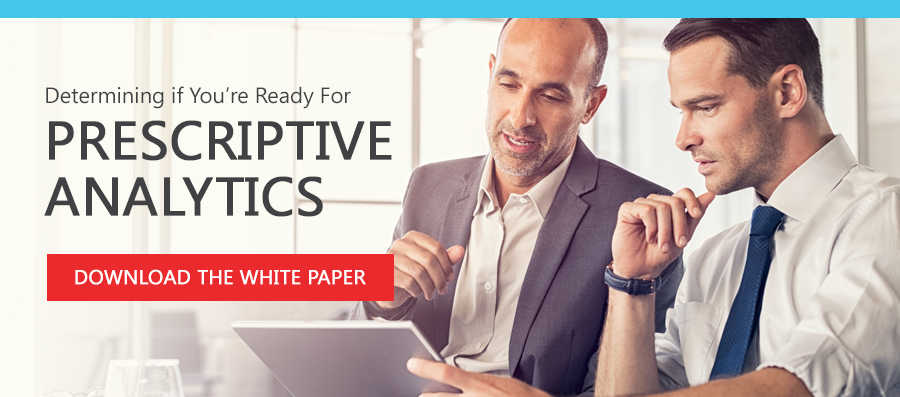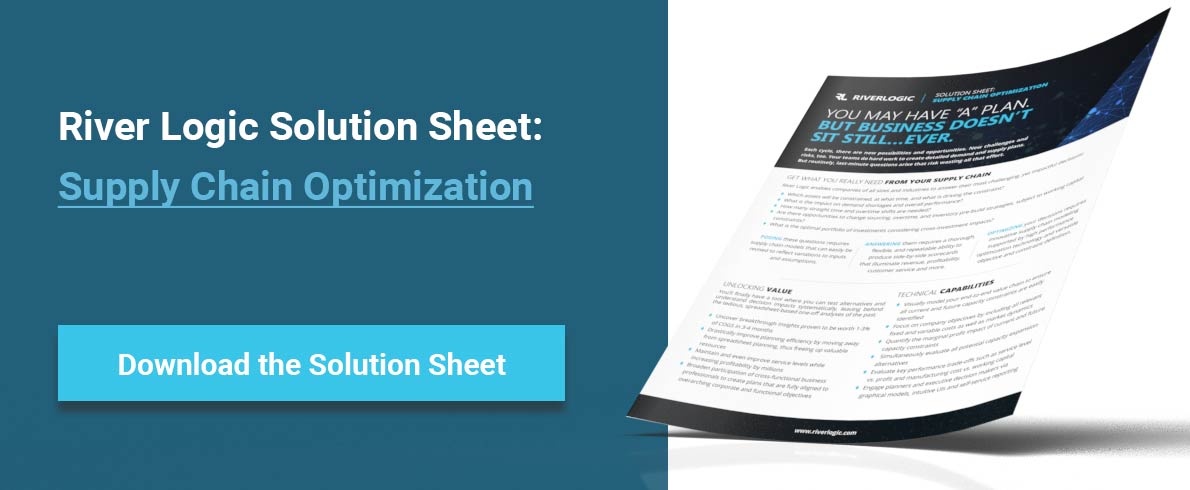But before buying analytics software, it’s best to take a step back and determine what’s right for your organization. There are numerous vendors selling different types of supply chain analytics software, but unless you’re ready for what they offer, you may be wasting your money.
In this blog, we’ll briefly run through the different types of software and consider their purpose. Then we will list nine key steps for evaluating the right supply chain analytics software.
Types of Supply Chain Analytics Software
In general terms, there are three types of supply chain analytics (although some commentators subdivide the list further into five categories). The most basic form of analytics is known as descriptive analytics. These are essential metrics and reports measuring past performance. Examples include sales ratios, supplier performance, and inventory turns. Descriptive analytics draws its information from historical structured data found in ERPs, CRMs and other corporate systems.
The next level is known as predictive analytics. Their purpose is to determine future trends so organizations can adjust strategies. Examples include predicting future demand and forecasting sales. A specific example of predictive supply chain analytics could be to predict a product’s life cycle and determine when it should be replaced.
Predictive analytics use advanced techniques such as machine learning, linear and nonlinear programming and artificial intelligence to determine the probability of certain events happening. Predictive analytics solutions typically work with structured and unstructured data. Structured data is organized data found in relational databases, while unstructured data includes information such as social media interactions, emails, call center transcripts and web browsing information.
The most advanced form of analytics is prescriptive analytics, which is used for various types of planning and decision support within or across functions. Prescriptive analytics takes information derived from descriptive and predictive analytics and uses that to determine the best actions to take in terms of predetermined criteria and goals. The key difference between predictive analytics and prescriptive analytics is that one tells you what will happen while the other what you need to do.

Choosing the Right Supply Chain Analytics Software
Here are nine steps to take to evaluate the right supply chain analytics software for your applications:
Type of analytics required
As with any form of advanced software, it’s essential to get the basics right first. It’s recommended you determine where you are and what you want to achieve. The first step is always to get your descriptive analytics right. Once you have done that, then it’s feasible to consider predictive and finally prescriptive analytics. It is possible to implement a solution offering both. Possibly the most important question you need to answer is what it is you wish to achieve.
Embedded or a separate package
Embedded analytics, part of ERPs, CRM and other supply chain software, often meet the need for descriptive analytics. While some enterprise software vendors also claim predictive analytics capabilities, this should be verified because few transactional-based software packages can also handle unstructured data. This distinction is important because a high percentage of usable data is unstructured. In most instances, predictive and prescriptive analytics software capable of modeling with unstructured data is separate and standalone.
Cloud or on-premise supply chain analytics software
Many supply chain analytics software vendors offer cloud-based solutions. This approach is flexible and cost-effective, especially for companies without sophisticated IT skills. In most instances, the vendor hosts the software, so there’s less to worry about. Easy scalability of cloud applications means solutions can grow as the business grows.
On-premise solutions are an alternative for organizations reluctant to let data outside corporate firewalls and who possess requisite IT and OR skills.
Packaged or platform
Packaged analytics solutions are good for well-defined instances such as for sales and retail, especially for descriptive analytics. Their weakness is they aren’t easily adapted to organizations that have different structures and ways of working, and in many instances, packages no longer cut it. Platforms have the advantage that they can be tailored to suit specific applications, although may be more complex and expensive.
Visualization
The ability to visualize and interrogate results is fundamental. Similarly, input information should be visible, and ideally, the model should have a degree of transparency allowing users to understand the model. In some instances, these features are built-in, but in others, they need to be developed.
Constraint or algorithm-based programming
For years, computer programming languages were based on the concept of writing syntax that told the computer what to do. As time went on, developers introduced high-level languages that allowed them to use statements that are similar to human languages. Leading on from this, they developed numerous algorithms (sets of instructions) able to analyze data and perform mathematical optimization. This approach is powerful but time-consuming.
The introduction of fifth-generation programming languages changed the way programs were written by focusing on constraints. Models are prepared around constraints, and this means the full impact of a constraint is taken into consideration. Fifth-generation constraint-based modeling uses visual tools that simplify model construction.

Coding skill requirements
A major factor to consider is the ongoing shortage of data scientists. This is inhibiting smaller businesses wanting to get into advanced supply chain analytics software partly because they can’t afford the fees demanded by data scientists.
This is one of the advantages of constraints-based programming because the visual interfaces are easier to use, and there’s no longer the need for pages and pages of hard coding. Nevertheless, it’s still essential to have the right skills, expertise and knowledge, a skill set met by citizen data scientists.
Cost
It’s no good moving into supply chain analytic software unless you have clearly identified your objective, how much it will cost and what benefits you hope to achieve. While descriptive analytics may cost less, predictive and prescriptive analytics can be expensive, especially if you go the hard coding route. This means top-level buy in is required as well as a commitment to see it through. Nevertheless, the potential ROI can far exceed the investment.
Vendor support
It’s important to clarify the degree of vendor support. Some vendors sell the software and effectively wash their hands of you, while others will stay at your side as you develop and implement the solution. Questions to ask include: Does the vendor have the skills and capability to help develop our supply chain analytic software, what’s their track record in this regard, and what will vendor support cost?
Getting Supply Chain Analytics Software Right First Time
As already highlighted, it’s essential to have a clear objective when implementing supply chain analytics software.
You need to look at aspects such as:
- The problem scope, definition, anticipated savings and implementation costs
- Will a package work or do you need a platform?
- Where will the software be hosted?
- The right type of software needed
- Hosted or on-premise
- Do you have the skill and team in place, or will you need to rely on a vendor?
- Total cost and ROI
- Vendor support
Only then are you ready to start evaluating options and deciding what you need for your BI/Analytics platform.







